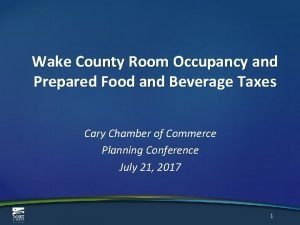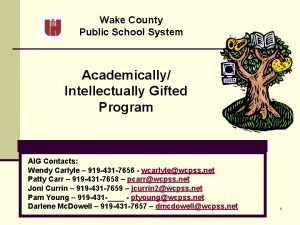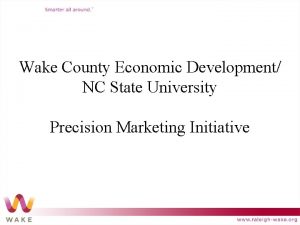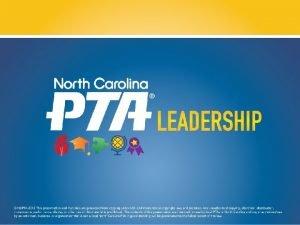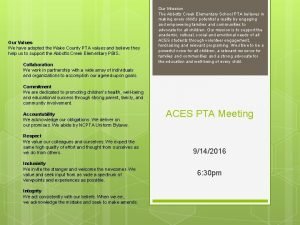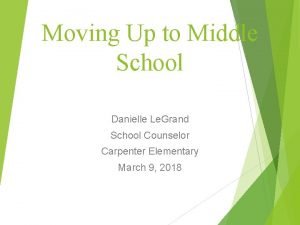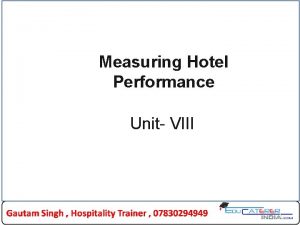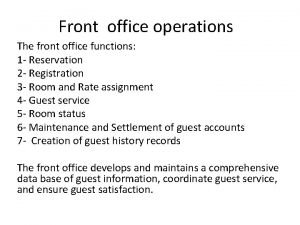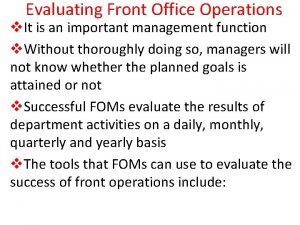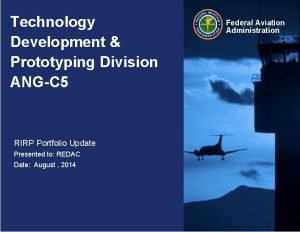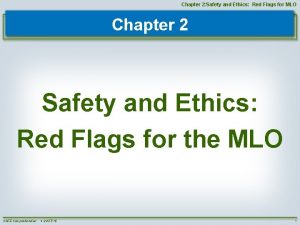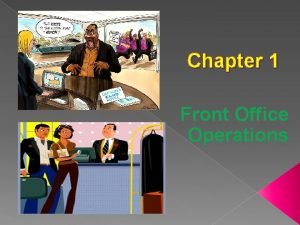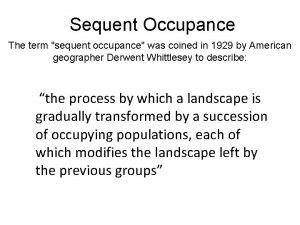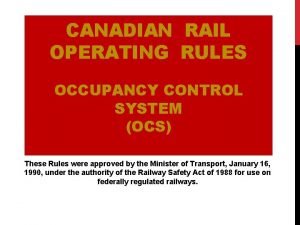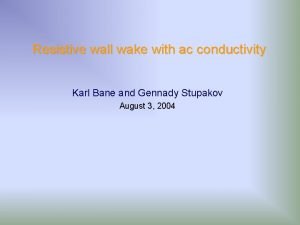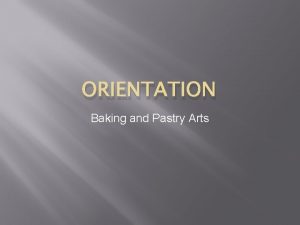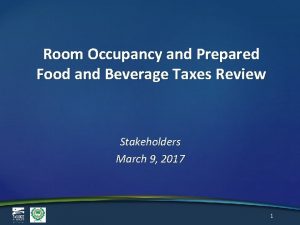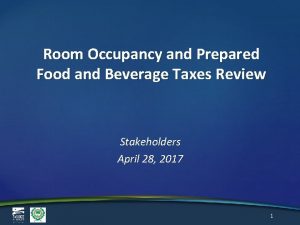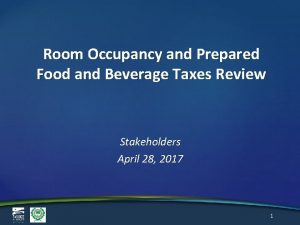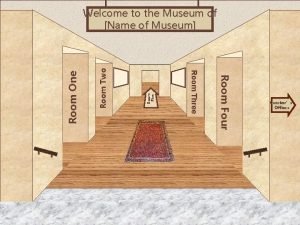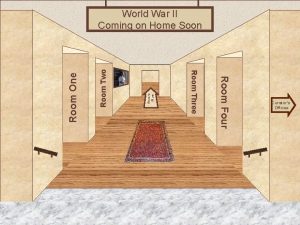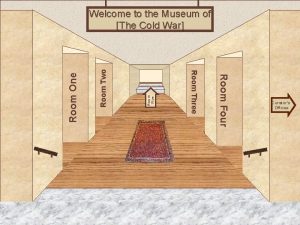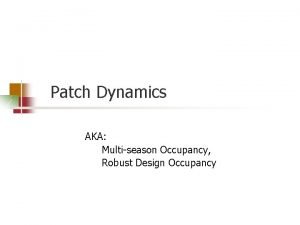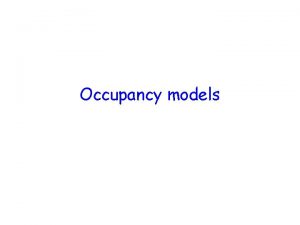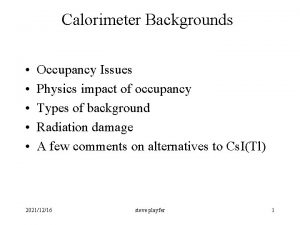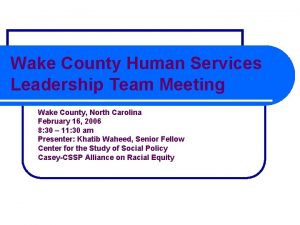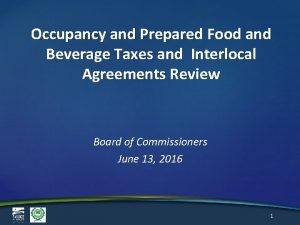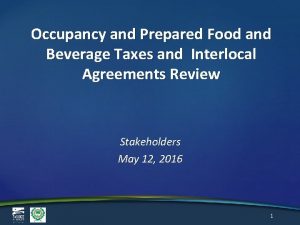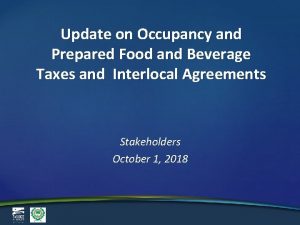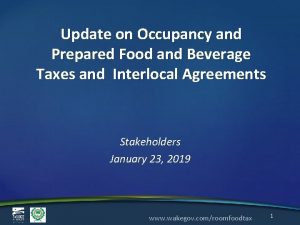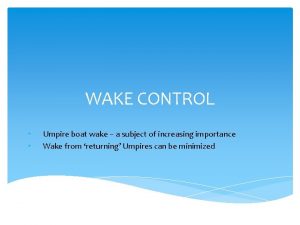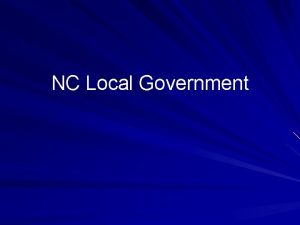Wake County Room Occupancy and Prepared Food and










































- Slides: 42

Wake County Room Occupancy and Prepared Food and Beverage Taxes Cary Chamber of Commerce Planning Conference July 21, 2017 1

Welcome and Why Are We Here • • • Wake County levies county-wide room occupancy and prepared food and beverage taxes Enabling legislation empowers City of Raleigh and Wake County to distribute the two tax revenues Legislation directs certain distributions and provides flexibility for others Every few years, Raleigh and Wake work with partners and stakeholders to review financial models and make decisions regarding revenues and community needs/desires In 2016, conducted a review (Phase I) and received feedback from Town of Cary and other Wake County towns that more focus and consideration should be given to Towns

2016/2017 Review • • • Completed earlier this year Developed principles and practices to guide future decisions Developed strategies/actions to better inform future decisions Established Small Projects Fund to support smaller dollar projects across the community Established Staff Team to monitor annual revenue growth and advise on planning/engagement efforts (includes representative from the Town of Cary) Established January 1, 2020 as due date for next review • Key actions to be completed by this date include Destination Strategic Plan (GRCVB) and Town of Cary Sports Facilities Comprehensive Capital Improvement Plans

Engaged Stakeholders • • Met in March and April with over 50 attendees at each meeting Representatives included: • • Municipalities Museums Hotels Restaurants Sports Performing Arts Regional Facilities (PNC Arena and Convention Center)

Background v v Authorizing legislation approved in 1991; amended in 1995 Tax levies 6% on occupancy stays; 1% on prepared food and beverage v v Revenues in 1995 = $12. 4 million Revenues in 2016 = $48. 6 million Revenues must be used for projects supporting arts, cultural, sports or convention Original Interlocal Agreement between City of Raleigh and Wake County in 1991; Revised in 1995 v There have been 20 Amendments to the Revised Interlocal Agreement 5

Occupancy Tax Revenue 6

Occupancy Tax Revenue 7 7

Occupancy Tax Distribution Per Legislation: • • • Administrative Fee - SL 1995 -458, Sec. 10 (a) City of Raleigh - SL 1995 -458, Sec. 10 (b)(1) Town of Cary - SL 1995 -458, Sec. 10 (b)(2) Wake County - SL 1995 -458, Sec. 10 (b)(3) Greater Raleigh Convention and Visitors Bureau (GRCVB) - SL 1995 -458, Sec. 10 (b)(4) Future Revenue Allocations - SL 1995 -458, Sec. 12

Prepared Food Tax Revenue 9 9

Prepared Food Tax Revenue 10 10

Food and Beverage Tax Distribution Per Legislation: • • • Administrative Fee - SL 1995 -458, Sec. 11 City of Raleigh - SL 1995 -458, Sec. 11(1) Wake County - SL 1995 -458, Sec. 11(2) Greater Raleigh Convention and Visitors Bureau (GRCVB) - SL 1995 -458, Sec. 11 (3) Future Revenue Allocations - SL 1995 -458, Sec. 13

Total Tax Collection by Jurisdiction (FY 2016) 12 *Not enough establishments to disclose collection numbers.

Example Projects Funded Arts and Culture Regional Facilities Cary Sports

Occupancy/F&B Revenues Overview (FY 2017) 14

FINANCIAL PLANNING MODELS

Financial Planning Models v v County serves as fiscal agent Financial models jointly maintained v v Major Facilities Cash Flow Model – Wake County Convention Center Complex Financing Plan - City of Raleigh Consider long-term expenditure commitments within a model sensitivity analysis to minimize project and financing risk with debt repayment the highest priority Maintain fund balance targets that provide adequate margin of error to minimize financing risk should revenue estimates fall short of projections 16

Financial Models – Major Facilities Cash Flow Model v Four Sections: I. Revenue Section v Economic growth assumptions (R 1 and R 2) v Sources of funds (R 3, R 4, R 5, R 6 and R 7) 17

Financial Models – Major Facilities Cash Flow Model • Section 1: • First dollars out – specific entities get money before funds are distributed to Raleigh and other projects: • Wake County Cost of Collection/Administration (1 a) • • City of Raleigh “Holdback” (1 b) • • Max 3% of gross proceeds for administering/collecting the taxes $680 K for visitor-related activities and programs Greater Raleigh Convention & Visitors Bureau (1 c) • Approximately 22% of total Occupancy taxes & up to $675, 000 Prepared Food and Beverage tax for operational expenses associated with promotion of travel, tourism and conventions 18

Major Facilities Cash Flow Model • Section 1: (Cont’d) • Town of Cary “Hold Harmless” (1 d) • • Centennial Authority (1 e) • • Approx. $5. 2 million annually; paid off in FY 2020 (Total = $60 M) PNC Maintenance (1 h) • • 7% for operational expenses for PNC Arena Debt Services (1 g) • • 5% of occupancy for public relations, and visitor-related programs and activities $1. 5 M to $5 M annually through FY 2021(Total = $22 M) Raleigh and Wake County (1 i and 1 j) • • • $1 million per organization per year for discretionary projects Raleigh supports Duke Energy Center for Performing Arts Wake supports Marbles, Five County Stadium maintenance and improvements and Green Square 19

Financial Models – Major Facilities Cash Flow 20

Financial Models – Major Facilities Cash Flow III. Section 2 - 85% Distribution • Calculates amount for distribution to City of Raleigh (2 a) 21

Financial Models – Major Facilities Cash Flow Model IV. Section 3 - 15% Projects Distribution • Lists and calculates amount for distribution to jointly approved projects 22

Financial Models – Major Facilities Cash Flow IV. Fund Balance • Identifies current and projected fund balance • Demonstrates Minimum Fund Balance Guideline (3 c) 23

Financial Models – Convention Center Complex v Existing Convention Center Debt Columns C, D and E 24

Financial Models – Convention Center Complex v v v Convention Center Operating Subsidy – Column G GRCVB Business Development Fund for Convention Center – Column H Convention Center Capital Maintenance Plan – Column I Performing Arts Center Capital Maintenance Plan – Column J 2 -for-1 Withdrawal (eliminated with 20 th amendment) – Column K 25

Financial Models – Convention Center Complex Model v v Transfers to support Major Facilities Model – Column L Other adjustments – Column M Interest Income – Column N Ending Fund Balance – Column O 26

Operating Principles and Practices

Operating Principles and Practices • Why did we develop Operating Principles and Practices? • Two organizations make decisions regarding funding for many interested parties • • • 28 Principles will help articulate values of stakeholders/ community Use principles to guide future decisions in keeping with values of stakeholders/ community Heard from stakeholders it’s difficult to understand administrative actions by City and County (i. e. revenue distributions, project priorities, financial policies/approach, decision making authority), especially if newcomer

Operating Principles and Practices • How did we develop Operating Principles and Practices? • • Staff Work Team developed draft documents Stakeholders discussed Principles and Practices in diverse small groups Staff Work Team amended/amending documents based on stakeholder input Both documents are intended to be working documents that will be updated as needed

Operating Principles A. B. C. D. E. Prioritize use of funds for projects that drive measurable, regular overnight visitation or positive return on investment (ROI) Support and promote the on-going capital expenditure program and expansion of existing investments in major facilities to keep them current, relevant and competitive in market Comply with all requirements of the existing enabling legislation Ensure project investments are secured by solid long-term plans, both operational and financial, that demonstrate viability and sustainability Utilize high standards of fiscal accountability in planning and managing the use of tax revenues: a. b. Fulfill existing obligations before entering into significant new financial commitments Maintain long-term, conservative financial forecasting Not in priority order.

Operating Principles, Cont’d F. G. H. I. J. K. L. Support investments that complement economic development efforts and enhance quality of life experiences for visitors, newcomers and long-time residents Create sports, arts and cultural opportunities, through leveraging community investments and partnerships, that benefit residents and enhance tourism offerings Support a project investment mix that considers location and types of uses (sports, cultural, arts, convention, etc. ) Engage stakeholders representing varying entities, jurisdictions and uses Ensure that investments support the long-term vision of Wake County and its cities and towns as a tourism destination Provide a regular funding source for eligible projects that require a smaller scale investment Support investments that consider emerging arts, sports and cultural experiences and unmet needs Not in priority order.

Ranking of Principles • • The March 9, 2017 stakeholders meeting identified 12 Guiding Principles for Use of Room Occupancy and Food and Beverage Taxes Attendees were asked to rank the 12 Principles based on the importance of the Principle to them • • 1 for Principle most important to you 12 for Principle least important to you Attendees were asked to select a constituency group they represented for purposes of ranking The results of the exercise are included in Table 1 below

Results of Ranking by Attendee Category Table 1: *highlighted cells represent avg scores of lower than 6

Operating Practices • • • Purpose: Articulate procedures and standards used in administering the two taxes. Approached development of the practices as if the reader was a new town manager with little to no history of the revenues. Executive oversight provided by Wake County and City of Raleigh managers. Reflect decisions through the 20 th Amendment. Practices categorized into two key areas: • • • General Operating Practices Financial Model/Plans Practices The attached Operating Practices document was shared in draft form with stakeholders on April 28. The staff work team will update the document based on stakeholder feedback.

Operating Practices • General Operating Practices – key elements 1. 2. 3. 4. 5. 6. • City of Raleigh and Wake County staff accountable for administration Stakeholder input opportunities City and County Managers make recommendations to elected bodies Project categories defined Capital maintenance/improvements coverage Project categories prioritized Financial Model/Plans Practices • • Countywide Major Facilities Cash Flow Model Practices Raleigh Convention Center Complex Financing Plan Practices

Next Steps

Destination Strategic Plan • • • Led by Greater Raleigh Convention and Visitors Bureau Goal – increase visitors and convention business from 15. 1 visitors in 2015 to 19. 5 million visitors in 2028 Three key objectives: • • Build consensus among stakeholders on trends impacting destination marketing industry and opportunities and threats to our community Identify and assess gaps in tourism infrastructure Recommend actions and activities for community Timeline – Complete late summer 2018

Town of Cary Facilities Planning • • • Town of Cary submitted request during Phase I for consideration of needs of sports facilities to remain competitive and attract events Recommending that Town of Cary conduct comprehensive Capital Improvement Plan for sport facilities (Wake. Med Soccer Complex, USA Baseball Complex and Cary Tennis Complex) Cost = Not to exceed $125, 000 Funding Source = FY 2017 Small Projects Fund Complete in 2018

Small Projects Funding Process • Wake County to begin process this fall • • Request Board approve process – late Summer 2017 Release RFP – Oct/Nov 2017 Receive Proposals – Jan/Feb 2018 Award Projects – Mar/Apr 2018 Maximum per project of $1. 5 M ~$3. 5 M available for FY 2017 and FY 2018 Anticipate two-year cycle

Webpage Under Design http: //www. wakegov. com/roomfoodtax/Pages/default. aspx

Additional Next Steps: • • • Continue work of Centennial Authority and City of Raleigh related to long term facility planning Engage Staff Work Team to monitor revenue growth and develop financial modeling scenarios for addressing future needs Complete next stakeholder review by January 1, 2020

Questions? 42
 Wake county prepared food tax
Wake county prepared food tax Let's look at some examples
Let's look at some examples Noncommercial food service examples
Noncommercial food service examples Aig program wake county
Aig program wake county Wake county economic development
Wake county economic development Wake county beekeepers
Wake county beekeepers Wake county aig identification
Wake county aig identification Wake county pta
Wake county pta Wake county human services community services center
Wake county human services community services center Wake county ems membership
Wake county ems membership Math 7 plus wake county
Math 7 plus wake county Latest nbc code
Latest nbc code Occupancy percentage formula
Occupancy percentage formula Front office personnel duties and responsibilities
Front office personnel duties and responsibilities Revpac formula in front office
Revpac formula in front office Spatial occupancy enumeration
Spatial occupancy enumeration Spatial occupancy enumeration
Spatial occupancy enumeration How to program verdant thermostat
How to program verdant thermostat Final approach runway occupancy signal
Final approach runway occupancy signal Information package example
Information package example Occupancy fraud red flags
Occupancy fraud red flags Sub department of front office
Sub department of front office Sequent occupance examples
Sequent occupance examples Canadian rail operating rules
Canadian rail operating rules Spatial occupancy enumeration
Spatial occupancy enumeration Ubbl staircase riser
Ubbl staircase riser Va loan intermittent occupancy
Va loan intermittent occupancy There a bedroom downstairs
There a bedroom downstairs To room nineteen sparknotes
To room nineteen sparknotes Hotel database sql queries
Hotel database sql queries Unit 2 food food food
Unit 2 food food food Food chain sequence
Food chain sequence Wake up and pay attention
Wake up and pay attention Family life stage
Family life stage Wake and bane
Wake and bane Wake tech baking and pastry arts
Wake tech baking and pastry arts Casseroling
Casseroling A carefully prepared and rehearsed speech
A carefully prepared and rehearsed speech Sharon milgram nih
Sharon milgram nih Strong oily odor in food storage room
Strong oily odor in food storage room Things fall apart locusts
Things fall apart locusts Andy chan wake forest
Andy chan wake forest Kelvin wedge
Kelvin wedge
